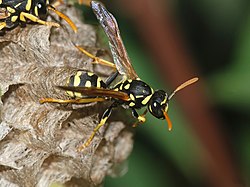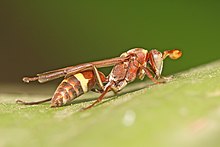| Revision as of 14:43, 4 December 2012 edit180.234.74.162 (talk) →References← Previous edit | Revision as of 14:49, 4 December 2012 edit undoXLinkBot (talk | contribs)Autopatrolled, Extended confirmed users, Pending changes reviewers719,065 edits BOT--Reverting link addition(s) by 180.234.74.162 to revision 525157074 (http://paper-wasp.blogspot.com/ )Next edit → | ||
| Line 50: | Line 50: | ||
| 2. http://www.myfoxchicago.com/dpps/news/study-paper-wasps-can-recognize-each-others-faces-dpgonc-20111202-fc_16206426 | 2. http://www.myfoxchicago.com/dpps/news/study-paper-wasps-can-recognize-each-others-faces-dpgonc-20111202-fc_16206426 | ||
| 3. | |||
| ] | ] | ||
Revision as of 14:49, 4 December 2012

Paper wasps are 0.7 to 1.0 inch (1.8 to 2.5 cm)-long wasps that gather fibers from dead wood and plant stems, which they mix with saliva, and use to construct water-resistant nests made of gray or brown papery material. Paper wasps are also sometimes called umbrella wasps, due to the distinctive design of their nests or other regional variants such as Trinidad & Tobago's use of Jack Spaniard.

Species
The name "paper wasps" typically refers to members of the vespid subfamily Polistinae, though it often colloquially includes members of the subfamilies Vespinae (hornets and yellowjackets) and Stenogastrinae, which also make nests out of paper. Twenty-two species of Polistes paper wasps have been identified in North America and approximately 300 species have been identified worldwide. The Old World tribe Ropalidiini contains another 300 species, and the neotropical tribes Epiponini and Mischocyttarini each contain over 250 more, so the total number of true paper wasps worldwide is about 1100 species, nearly half of which can be found in the neotropics.
Nests

The nests of most true paper wasps are characterized by having open combs with cells for brood rearing, and a 'petiole', or constricted stalk, that anchors the nest (see image, right). Paper wasps secrete a chemical which repels ants, which they spread around the base of the anchor to prevent the loss of eggs or brood.
Most social wasps of the family Vespidae make nests from paper, but some stenogastrine species, such as Liostenogaster flavolineata, use mud. A small group of eusocial crabronid wasps, of the genus Microstigmus (the only eusocial wasps outside the family Vespidae), also construct nests out of chewed plant fibers, though the nest consistency is quite different from those of true paper wasps, due to the absence of wood fibers, and the use of silk to bind the fibers.
Nests can be found in sheltered areas, such as the eaves of a house, the branches of a tree, or on the end of an open pipe (for example, of an old clothesline).
Behavior
Unlike yellowjackets and hornets, which can be very aggressive, polistine paper wasps will generally only attack if they themselves or their nest are threatened. Since their territoriality can lead to attacks on people, and because their stings are quite painful and can produce a potentially fatal anaphylactic reaction in some individuals, nests in human-inhabited areas may present an unacceptable hazard.

Most wasps are beneficial in their natural habitat, and are critically important in natural biocontrol. Paper wasps feed on nectar, and other insects, including caterpillars, flies, and beetle larvae, and they are often considered to be beneficial by gardeners.
Facial recognition
Recent research has discovered paper wasps have face recognition abilities comparable to humans. One recent study conducted at the University of Michigan in Ann Arbor showed paper wasps have the same facial recognition abilities common to humans or chimps.
"Faces are extremely important to species such as humans", said the study coauthor Michael Sheehan, a Ph.D. candidate at the university. "Studies show that when you look at a face, your brain treats it in a totally different way than it does other images," he said. "It's just the way the brain processes the image of a face, and it turns out that these paper wasps do the same thing."
The study consisted of a series of tests on the Polistes fuscatus species of paper wasp. This particular species is unique in that it has extremely variable facial patterns from member to member. Sheehan and evolutionary biologist Elizabeth Tibbetts placed individual wasps into a T-shaped maze, with one image shown at each end of the top T arm. Images varied from caterpillars, simple geometric patterns, and computer-altered wasp faces to pictures of a genuine paper wasp faces. These images were interchanged randomly during testing.
According to Sheehan, whenever the wasp in the maze chose the side of the T arm with the correct picture, it would get a reward, in this case a safety zone. Though images were always changed, "one particular image was always associated with the safety zone," Sheehan explained. Once the wasps associated the right image with the safety zone, they were able to choose the correct image and thus get to the safety zone essentially every time after. This suggests that the paper wasps' brains are tuned to recognize faces of their own species -- as with humans.
"Wasps and humans have independently evolved similar and very specialized face-learning mechanisms, despite the fact that everything about the way we see and the way our brains are structured is different," Sheehan said. "That's surprising and sort of bizarre." The unique, distinct faces of paper wasps, as well as the wasps' ability to recognize and remember each other's faces, are likely tied to the insects' multicolony social structure, Sheehan added. "They have multiple queens and they all want to reproduce—they all want to be the most dominant. So being able to recognize each other helps them understand who's already beaten who, who has higher ranking in the hierarchy, and this helps to keep the peace."
See also
References
- "Paper Wasp" Microsoft Encarta Online Encyclopedia 2006.
- What's That Bug.
- ^ W.F. Lyon and G.S. Wegner (1991) Paper Wasps and Hornets Ohio State University Extension Fact Sheet: Entomology
- Matthews, R. W.; Starr, C. K. (1984). "Microstigmus comes Wasps have a Method of Nest Construction Unique Among Social Insects". Biotropica. 16 (1): 55–58. doi:10.2307/2387895.
- Felixson, Carol (undated), "Paper wasps work together." Retrieved 2009-04-26 from "L.A. Times" at http://www.latimes.com/features/kids/readingroom/la-et-kidcal5mar06,1,7872696.story.
- ^ Drees, B.M. and John Jackman (1999) Field Guide to Texas Insects, Gulf Publishing Company, Houston, Texas. Excerpt available at: Texas Cooperative extension
- Template:Web
- M. J. Sheehan & E. A. Tibbetts (2011). Specialized Face Learning Is Associated with Individual Recognition in Paper Wasps. Science. 334. 1272-1275.